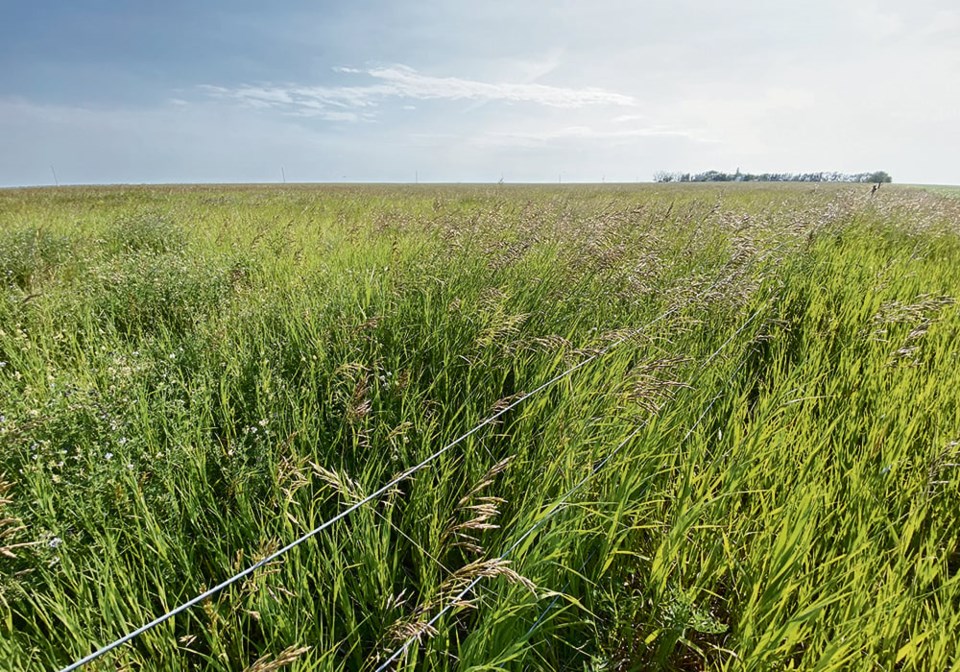SWIFT CURRENT, Sask. — A project looking at 4R nitrogen management in forage stands found nitrification inhibitors will boost yields and reduce nitrogen losses, but results will depend on rain.
Jordan Johnson, livestock and feed extension specialist at Saskatchewan Agriculture, said forage productivity declines over time and, like any other crop, will benefit from fertilizer.
“Now more than ever, with increasing land prices and increasing costs of feed, it’s important to maximize that productivity not only for your own risk management but for the longevity of the industry as well,” she said during a presentation at Foraging into the Future.
“Forage stands are kind of the forgotten child, a little bit, of the fertilizer industry. It’s important to remember that they too remove nutrients during haying.”
Johnson said removing one ton of hay from a field also removes between 34 and 60 pounds of nitrogen, 10 to 15 lb. of phosphorus, 40 to 60 lb. of potassium and about six lb. of sulfur.
In some parts of the province, removing two tons each year is common, resulting in depleted soil nutrients.
She said fertilizing forage is a risk management strategy, considering the cost to buy and transport feed.
The project, conducted under the province’s Agriculture Demonstration of Practices and Technologies, or ADOPT program, took place from 2020-22.
Last year’s sites were at Weyburn, Yorkton and Clavet. Johnson did not present data for the Clavet project because it is still being analyzed.
Broadcasting fertilizer on forage is the most common practice for its simplicity and low disturbance but this method increases the risk of nitrogen loss.
The project tested several inhibitor products for their effectiveness. Johnson said even though it was extremely dry in 2020 and 2021 the products worked when compared to doing nothing.
The study was conducted on stands more than eight years old, with less than 30 percent alfalfa and with no history of fertilization or manure application.
A fertilizer blend of 68 lb. of nitrogen, 20 lb. of phosphorus and 30 lb. of potassium per acre was applied at all sites.
The work included soil testing spring and fall, measuring rainfall, determining forage yield and quality, basic economics and estimated nitrogen loss through volatilization, Johnson said.
Three tubes per plot measured the nitrogen emissions as ammonia for 28 days; they were checked twice per week. Each site had four treatments, including a control and fertilizer without an inhibitor product.
At Weyburn, one plot had a urease inhibitor and the other used a product with both urease and nitrification inhibitors.
The products were floated on May 19, the forage cut July 12, baled July 24 and the sites received 10.5 inches of rain.
Johnson said from the day after fertilization occurred, the untreated plot showed big jumps in nitrogen loss as ammonia.
“That’s pretty shocking because on day two after we fertilized that plot, we had an inch-and-a-half of rain,” she said.
The data show that any fertilizer improves yield. The control produced 1,705 lb. per acre, compared to 2,924 lb. for the untreated fertilizer, 3,143 lb. with the urease inhibitor and 3,500 lb. with the urease and nitrification inhibitor.
Johnson said the economic analysis showed total cost, including cutting, baling and land rent, at $77 per acre for the control up to nearly $250 per acre for the combined product.
When calculated as cost per pound fed, the control was about 4.2 cents while the latter was 6.4 cents.
“If you can produce hay for about seven cents a pound, that’s cheaper than going out and buying it for 10 cents a pound,” she said.
At Yorkton, the control and untreated plots were joined by a plot with a different urease inhibitor and one for nitrification only.
The fertilizer was applied June 4, which is later than ideal, Johnson said. The hay was cut July 24, baled Aug. 10 and the field received 14.5 inches of rain.
“The urease inhibitor reduced losses and the nitrification product is out there with the untreated (plot),” said Johnson, showing a graph of losses. “That’s not a surprise because nitrification inhibitors don’t protect against losses of ammonia.”
Total costs per acre were higher at this site, ranging from $89 per acre on the control to $252 for the urease product and $257 for the nitrification inhibitor.
However, the yields were also much higher at 3,442 lb. for the control, 4,278 lb. for the untreated plot, 4,883 lb. with the urease product and 5,334 lb. with the nitrification product.
On a per pound fed basis, the costs were 2.6 cents per lb. on the control, 5.5 cents on untreated, 5.2 cents with urease and 4.8 cents with the nitrification product.
Johnson said producers should consider that both study sites received a good amount of timely rain. But she said even with the high fertilizer costs this year the total forage production costs were still lower than forage market value.
“Using those nitrogen loss inhibitor products, promoting that use of 4R, actually reduced the cost of fertilizer and reduced the nitrogen loss, with the exception of the nitrification inhibitor,” she said. “Be sure to use a product that has a urease inhibitor on it because we saw that it had the best nitrogen retention across the board.”




